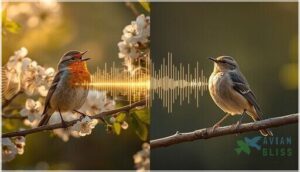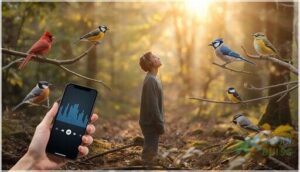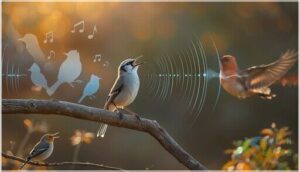This site is supported by our readers. We may earn a commission, at no cost to you, if you purchase through links.
 Step outside on a spring morning and the air fills with sound—whistles, trills, rattles, even a few names spoken aloud by the birds themselves. Chickadee. Whippoorwill. Pewee. Each species leaves its own acoustic fingerprint, from the flute-like song of a thrush to the sharp chip of a cardinal.
Step outside on a spring morning and the air fills with sound—whistles, trills, rattles, even a few names spoken aloud by the birds themselves. Chickadee. Whippoorwill. Pewee. Each species leaves its own acoustic fingerprint, from the flute-like song of a thrush to the sharp chip of a cardinal.
The names of bird sounds aren’t just labels—they’re clues to behavior, identity, and the secret language of the wild. Once you start listening, you’ll notice patterns, personalities, and even hidden messages woven into the chorus. Understanding these sounds unlocks a new way to connect with the world just beyond your window.
Table Of Contents
- Key Takeaways
- Types of Bird Sounds
- Bird Sounds and Language
- Identifying Birds by Sound
- Bird Song Vs. Bird Call
- Learning Bird Songs and Calls
- Birds With Distinctive Sounds
- Bird Sounds in Massachusetts
- Timing of Birdsong
- Challenging Bird Sounds
- Exploring Bird Sounds Further
- Frequently Asked Questions (FAQs)
- What are the different bird sounds called?
- How do I identify a bird by its sound?
- What bird makes several different sounds?
- What bird calls sound like names?
- What are the primary purposes of bird vocalizations?
- Can birds produce more than one sound simultaneously?
- How do environmental factors affect bird sound production?
- Can bird sounds be used to detect climate changes?
- How do weather conditions affect bird sounds?
- Can birds lose their ability to vocalize?
- Conclusion
Key Takeaways
- Birds produce three main categories of sounds—vocal songs and calls for communication, imitative vocalizations that mimic other species or environmental noises, and non-vocal mechanical sounds created by wing movements or feather vibrations.
- Bird songs are long, complex, and learned vocalizations used primarily by males during breeding season to attract mates and defend territory, while bird calls are short, instinctive sounds that serve practical functions like warning of danger or maintaining flock cohesion year-round.
- You can identify birds by listening for specific acoustic features including pitch, rhythm, and pattern repetition, with tools like Merlin Bird ID and field practice helping you distinguish between species that share similar sounds.
- Environmental factors like urban noise pollution, habitat structure, and seasonal changes directly influence how and when birds vocalize, with many species adapting their songs to higher frequencies or earlier dawn times in response to human activity.
Types of Bird Sounds
Birds produce sounds in more ways than you might expect. Some imitate what they hear in their environment, while others create noise without using their voices at all.
Let’s look at three distinct categories that showcase the variety of sounds you’ll encounter in the bird world.
Imitative Sounds
Why do some birds sound like chainsaws or car alarms? That’s vocal mimicry at work. Around 9% of songbird species imitate other sounds, from predator calls to mechanical noises. You’ll hear striking examples in:
- Mockingbirds belting out 200 different songs
- Lyrebirds copying camera shutters
- Drongos faking alarm calls to steal food
- Brown Thrashers cycling through 3,000 variations
- Blue Jays mimicking hawks to clear feeders
This mimicry prevalence shows how birds learn and transmit sounds through observation, shaping their acoustic features for survival and communication. Some birds, like the Yellow-Breasted Chat, have an astonishing repertoire of sounds.
Non-Vocal Sounds
Beyond songs and bird calls, nature’s mechanical sound functions work overtime. Over 30% of bird families employ wing sound mechanisms, such as hummingbirds buzzing at 858 Hz, pigeons whistling alarms, and grouse drumming. This non-vocal diversity holds evolutionary significance for courtship and danger signals. For instance, the blue-capped cordon-bleu uses tap dancing displays during courtship. These acoustic properties aid in bird identification when studying bird behavior.
| Species | Sound Type |
|---|---|
| Hummingbirds | Wing buzz during flight |
| Crested Pigeons | Feather-generated alarm whistle |
| Ruffed Grouse | Chest drumming display |
| Manakins | Wing snaps (60/minute) |
| Owlets | Competitive rattling sounds |
Unique Sounds
Some bird calls go beyond standard songs and mechanical sounds into truly remarkable territory. These extreme frequencies and vocal mimicry abilities make certain species instantly recognizable. You’ll encounter:
- White Bellbird: Produces the loudest bird sound at 125 decibels, like a jackhammer.
- Lyrebird: Masters vocal mimicry, replicating chainsaw sounds and camera shutters.
- Club-winged Manakin: Creates electronic-sounding mechanical sounds by rubbing feathers together 107 times per second.
- Northern Mockingbird: Mimics over 200 unique sounds from other species.
Bird Sounds and Language
Bird sounds have inspired a rich vocabulary in human language. We use both descriptive words that capture the quality of a sound and imitative words that mimic what we hear.
Understanding these terms helps you connect the sounds you encounter in the field with the language birders use to describe them.
Descriptive Words for Bird Sounds
When you’re learning bird sound descriptions, you’ll encounter terminology that goes beyond simple onomatopoeia. Research shows that “chatter” and “chirp” top sound descriptor preference studies, outranking terms like “buzz” or “moan” in listener recognition. Acoustic characterization connects these names of bird sounds to measurable beat rates—Plumbeous Vireo songs register 40–60 Hz, while Common Nighthawk peents reach 240 Hz.
| Descriptor | Example Species | Acoustic Character |
|---|---|---|
| Chatter | Magpie Lark | High-frequency rapid notes |
| Trill | Northern Parula | Variable 20–30 Hz buzzy rise |
| Screech | Satin Bowerbird | Sharp, distinct quality |
| Whistle | Various songbirds | Clear, pure-tone sound |
Understanding bird sound vocabulary requires recognizing how linguistic influences shape your perception. Onomatopoeic words like “coo,” “caw,” and “warble” appear across languages, while quantitative resources like Xeno-canto’s 600,000+ recordings help standardize these descriptors through community agreement and scientific validation.
Imitative Words for Bird Sounds
Onomatopoeia prevalence in bird naming runs deep—over one-third of species names across 17 languages stem from mimicked sounds. You’ll find cross-linguistic patterns where “cuckoo” and “chickadee” transcend borders.
These onomatopoeic words serve cognitive functions, helping you learn calls faster. Citizen science projects report 40% higher accuracy when using imitative bird sound vocabulary, with statistical examples showing five bird calls gaining universal consensus among observers.
Meaning and Purpose of Bird Sounds
Communication forms the backbone of survival for most avian species. When you hear bird sounds, you’re witnessing complex exchanges that serve essential functions. Bird calls and bird songs evolved to handle specific needs:
- Mate attraction through elaborate vocalizations during breeding season
- Territory defense using repeated songs to mark boundaries
- Alarm signaling with sharp calls warning of predators
- Social cohesion maintaining flock coordination through contact calls
Identifying Birds by Sound
Listening closely to birds can tell you more than you might expect. Each sound holds a clue to the bird’s identity and habits.
Here’s what to listen for when trying to recognize birds by their calls and songs.
Using Bird Sounds for Species Identification
Ever wondered how experts pick out a sparrow from a warbler just by sound? You can do it too—if you know what to listen for. Chirps, hoots, trills, and caws each point to specific species.
With bird sound identification apps and acoustic monitoring, even overlapping sounds become clues. Larger dataset size boosts app accuracy, and citizen science keeps these tools sharp.
Your ears are key to bird species identification.
Common Bird Sounds in Massachusetts
What’s the soundtrack of Massachusetts outdoors? In spring, you’ll hear urban bird songs from House Wrens, forest bird calls from Northern Flickers, and wetland bird sounds from Mourning Doves. Coastal bird vocalizations and migratory bird sounds add variety.
Use bird sound identification apps and local resources to tune your ear to these common bird sounds and sharpen your skill in identifying bird vocalizations.
Tips for Recognizing Bird Songs
Think of bird song recognition like learning a new language. Start with dawn listening—birds are most vocal then. Pay attention to rhythm analysis and use mnemonic devices to remember patterns. Visual confirmation helps too; watch for movement while listening.
Practice strategies matter: repeat exposure, use birdwatching apps, and compare bird song vs bird calls to sharpen your skills in identifying bird sounds.
Bird Song Vs. Bird Call
Birds use both songs and calls, but each has a different purpose. Understanding the difference can help you recognize what you’re hearing outdoors.
Here’s what sets bird songs and calls apart.
Definition of Bird Song
Did you know a bird’s song acts like a musical résumé? Birdsong stands out for its complexity and learned patterns, shaped by vocal learning and acoustic features. Males use these elaborate tunes to claim territory and attract mates. Song dialects and song complexity even influence birdsong evolution and fitness.
| Feature | Description |
|---|---|
| Complexity | Long, varied |
| Purpose | Mate, territory |
| Learning | Auditory, practice |
| Dialects | Local variations |
Definition of Bird Call
Unlike the long, intricate songs, bird calls are short and practical—think of them as quick messages. You’ll hear them when birds warn of danger, signal food, or keep their flock together. Their call acoustic structure is brief, yet each species has a distinct call repertoire size. Contextual call variation helps with bird sounds identification.
| Call Type | Purpose | Example Use |
|---|---|---|
| Contact Call | Stay together | Flock movement |
| Alarm Call | Warn of danger | Predator spotted |
| Food Call | Signal food | New food source |
Differences Between Bird Song and Bird Call
You’ve seen how bird calls work—now let’s look at bird songs. Songs carry more weight, often lasting several seconds, packed with song complexity and rich acoustic parameters. These types of bird sounds help males attract mates or mark territory, mostly in spring mornings.
Calls, on the other hand, serve practical call functions like alarms or keeping the flock together. Context timing matters: songs peak during breeding, while calls happen year-round.
Here’s a quick comparison:
| Feature | Bird Song |
|---|---|
| Length | Long, complex |
| Function | Mate, territory |
| Learning Process | Learned |
| Timing | Breeding season |
Learning Bird Songs and Calls
Learning to recognize bird songs and calls starts with a few practical steps. Where you listen and what you focus on can make a big difference. Here are some ways to get started.
Choosing The Right Location
When you’re out birdwatching, your choice of location shapes what you’ll hear. For better bird species identification, look for spots with diverse habitat acoustics and low urban noise. Early spring mornings boost bird calls and songs. Familiar places help with bird sounds. Try these:
- Local parks with layered vegetation
- Quiet forest edges
- Green city spaces
- Wetlands
- Wooded trails
Focusing on Frequent Calls
After picking the right spot, tuning your ear to frequent bird calls is where the real learning begins. These calls make up most of what you’ll hear, especially in spring, and they’re key to birdwatching success. For instance, a House Wren may call hundreds of times an hour. Try listening for:
- Repeating patterns, like the steady “birdy-birdy-birdy” of a Northern Cardinal
- Context clues—calls change with season and time
- Subtle shifts in pitch or rhythm, revealing species detection and acoustic characteristics
Birds With Distinctive Sounds
Some birds stand out because their sounds are instantly recognizable. You’ll notice that certain species have calls or songs unlike any others.
Here are a few birds known for their distinctive voices.
Birds With Sounds Like Names (e.g. Chickadee, Pewee)
Ever noticed how some bird names echo their calls? The chickadee’s “chick-a-dee-dee” and pewee’s “pwee” are perfect examples of sound mimicry and onomatopoeic words for bird calls.
These naming origins aren’t just clever—they offer a practical identification aid. Regional variations and cultural significance shape bird sound names, making it easier for you to identify bird sounds.
Birds With Unique Vocalizations (e.g. Whippoorwill, Chuck-wills-widow)
Nightjar vocalizations stand out among bird sounds. You’ll hear the Eastern Whip-poor-will repeat its call over a thousand times in one night, especially during breeding season. The Chuck-wills-widow’s rolling song is slower and deeper.
For bird identification, these avian vocalizations offer:
- High call repetition
- Unique syllable patterns
- Seasonal activity tied to breeding
Birds With Mimicry Abilities (e.g. Bobolink, Flicker)
Mimicry in birds is a fascinating window into avian vocalizations. You’ll find Bobolinks weaving bits of other bird songs into their own, while Northern Flickers often become the imitation targets of skilled mimics. Mimicry evolution brings benefits like territorial defense and mate attraction, and its complexity varies across geographic distribution.
Here’s a quick look:
| Species | Mimicked Sounds | Mimicry Benefits |
|---|---|---|
| Bobolink | Blue Jay, Robin, Frog | Territory defense |
| Flicker | Car alarms, sirens | Mate attraction |
| Mockingbird | 200+ bird species | Territory, mating |
Bird Sounds in Massachusetts
Massachusetts is home to a wide range of bird voices you’ll hear throughout the year. If you know what to listen for, you can spot many species just by their sounds.
Here are some of the most common bird calls and songs you’ll encounter across the state.
10 Common Bird Sounds in Massachusetts
What’s the soundtrack of a Massachusetts morning? You’ll hear the Cardinal Whistle, the Chickadee-dee-dee, and the soft Dove Cooing. These bird sounds tell you who’s nearby without even looking.
For quick bird identification, a bird ID app can help you match calls like the Wren Bubbly or the Catbird Mew—making identifying bird sounds much easier.
- Cardinal Whistle
- Chickadee-dee-dee
- Dove Cooing
Identifying Bird Songs in Massachusetts
How do you pick out a Warbler’s song from the Dawn Chorus in Massachusetts? Start by listening for song complexity and patterns—many birds, like the Baltimore Oriole, add their own twist.
Merlin Sound ID and other bird ID apps can help you with species identification, especially when noise pollution makes identifying bird sounds and calls tricky. Practice sharpens your ear!
Timing of Birdsong
Birdsong isn’t just about what you hear—it’s also about when you hear it. Different birds sing at different times and for different reasons.
Here’s a look at how timing shapes the sounds you notice outdoors.
Dawn Chorus
Ever notice how the world wakes up with a burst of bird sounds? The dawn chorus is more than morning music—it’s songbirds staking their claim and seeking mates.
You’ll hear striking chorus acoustic complexity, with species diversity peaking in spring. Urban birds start earlier than rural ones. Understanding dawn chorus function helps you sharpen bird identification skills through bird calls and songs.
Year-Round Singing (e.g. Robins)
While the dawn chorus fades, robins keep singing through winter. Their year-round vocalization isn’t just a cheerful tune—it’s key for Territory Defense and Survival Rates. You’ll notice longer phrases and higher minimum frequencies, especially in cities. This Urban Adaptation shows striking Vocal Plasticity and Seasonal Variation, making robins reliable guides for identifying bird sounds.
- Longer winter phrases
- Higher pitch in urban areas
- Consistent song rates day and night
- Songs defend territory year-round
- Vocal plasticity aids survival
Seasonal Changes in Birdsong
Just as robins sing through winter, most birds shift their tunes with the seasons. Spring bird migration brings new calls for navigation and attracting a mate. Breeding season sparks complex songs for territory defense.
Climate influence and habitat differences shape these patterns. Neural adaptations even alter song rates, so listen closely—each change tells you something about their world.
Challenging Bird Sounds
Some bird sounds can be tricky to tell apart, even for experienced listeners. Certain species share similar calls or change their voices depending on the situation.
Here’s a look at a few examples that often cause confusion.
Birds With Similar Sounds (e.g. Veery and Vireo)
In bird sounds, acoustic overlap can make field misidentification a real challenge. Veery and vireo songs often blur together, but you can sharpen your bird identification skills by focusing on:
- Song similarity and subtle pitch changes
- Technological solutions like BirdNET
- Habitat influence—forest versus woodland
- Careful sound recognition in mixed-species areas
Birds With Variable Vocalizations (e.g. Towhee, Pipit)
When you’re sorting through bird sound variations, Towhees and Pipits really keep you guessing. Their vocalizations shift with geography, age, and even personality—like local accents in people.
Towhees mix mimicry into their calls, while Pipits show off population dialects and trill constraints. Tracking these bird vocalizations means tuning in to song diversity and the subtle sounds of different birds.
Tips for Identifying Difficult Bird Sounds
Ever wonder how to crack the code of tough bird sounds? Start by tuning your ear to frequency analysis and rhythm recognition. Training methods like field practice and quizzes sharpen listening skills. Lean on automated tools for bird identification, but watch out for error sources—overlapping calls or background noise. Explore bird sound categories and compare common bird calls for clearer identification.
- Listen for pitch and tempo shifts
- Use bird ID apps for frequency analysis
- Practice with field recordings and guides
- Focus on repeated rhythm patterns
- Note error sources like environmental noise
Exploring Bird Sounds Further
If you’re ready to sharpen your ear for bird sounds, there are some practical activities you can try. These ideas can help you build confidence and skill with each session.
Here’s what you can do next to keep improving.
Activities for Improving Bird Sound Identification
Ready to sharpen your listening skills and bird identification? Think of it as tuning your ear like a musician. You’ll learn more by mixing activities:
- Try sound matching games and AI-assisted training apps to practice bird sound categories.
- Join group listening walks with fellow bird watchers for memory association and real-time feedback.
- Use gamified learning quizzes to improve identifying birds sounds and boost recall.
Encouragement to Continue Learning
Curiosity fuels learning persistence in bird identification. Adaptive encouragement—like joining bird clubs or exploring sound apps—keeps motivation high. Positive reinforcement comes from every new bird sound you recognize. Try these engagement strategies:
| Engagement Strategy | Benefit |
|---|---|
| Birdwatching apps | Quick bird sound ID |
| Field guides | Detailed call descriptions |
| Sound recordings | Practice at home |
| Local bird clubs | Shared experiences |
| Online communities | Diverse learning resources |
Frequently Asked Questions (FAQs)
What are the different bird sounds called?
Birds make a range of sounds called songs, calls, and non-vocal noises. You’ll hear onomatopoeic terms like “hoot” or “chirp,” each reflecting unique acoustic features, vocalization purpose, and species naming based on bird sound variations.
How do I identify a bird by its sound?
If Beethoven had a smartphone, he’d use Merlin Bird ID to match bird songs. Focus on pitch, rhythm, and timbre—these auditory identification cues, plus technological aids, help you decode bird communication methods and tackle identification challenges outdoors.
What bird makes several different sounds?
If you’re looking for a bird that makes several different sounds, the Northern Mockingbird stands out. Its vocal mimicry and large repertoire size let it imitate other birds, create complex songs, and adapt its calls for varied bird communication.
What bird calls sound like names?
You know what they say: the name says it all. Chickadees announce their “chick-a-dee” calls at 2-8 kHz frequencies. Killdeer shout “kill-deer” repeatedly. Bobwhites whistle their own “bob-white” greeting.
What are the primary purposes of bird vocalizations?
You’ll hear birds vocalizing to attract mates, defend territories, sound alarm calls, maintain social cohesion through communication calls, and recognize individuals—each sound serving specific purposes in bird behavior and survival.
Can birds produce more than one sound simultaneously?
The Northern Mockingbird demonstrates dual vocalization brilliantly, layering multiple sounds simultaneously through independent syrinx control.
This acoustic complexity enhances territorial displays and mate attraction, showcasing striking avian sound patterns that exemplify sophisticated bird behavior and vocalization capabilities.
How do environmental factors affect bird sound production?
Environmental factors like noise pollution, habitat structure, and climate change influence bird sound production.
Urban birds sing at higher frequencies and amplitudes to overcome noise. Dense forests encourage lower-frequency vocalizations for better transmission through vegetation.
Can bird sounds be used to detect climate changes?
Birds serve as canaries in the coal mine for climate shifts. Their vocalizations reveal phenological shifts, range changes, and vocal modifications.
Acoustic indices and soundscape ecology track these avian sounds, detecting ecosystem responses to warming temperatures.
How do weather conditions affect bird sounds?
Weather shapes avian sounds dramatically. Rain impact and wind noise mask vocalization, while temperature effects alter pitch and timing.
Humidity influence affects sound transmission, and light modulation shifts when birds sing—all influencing communication patterns.
Can birds lose their ability to vocalize?
Yes, through syrinx damage, neural injuries, or environmental impacts, birds’ vocalization can be affected. Hormonal influence also plays a role in their vocalization.
Some species show vocal recovery through avian communication adaptations, while others experience permanent changes in bird behavior and sounds.
Conclusion
There’s a theory that birds sing just for themselves—but listening proves otherwise. Every call has a purpose, every song tells a story. Now that you know the names of sounds of birds, the dawn chorus becomes more than noise.
It’s communication, territory, courtship, alarm. Step outside tomorrow morning. Close your eyes. Let the identities reveal themselves. You’re no longer just hearing birds—you’re understanding them.
- https://news.wisc.edu/why-do-birds-make-so-many-different-sounds-a-new-uw-madison-study-gets-at-the-underlying-factors/
- https://en.wikipedia.org/wiki/Bird_vocalization
- https://www.mpg.de/16209353/1222-orni-global-study-on-bird-song-frequency-154562-x
- https://www.sciencedirect.com/science/article/abs/pii/S1574954122003776
- https://www.massaudubon.org/news/latest/10-common-bird-sounds














